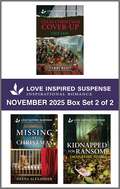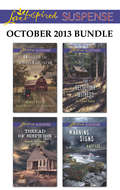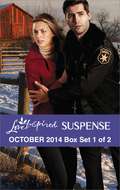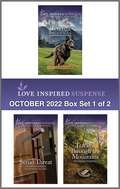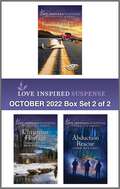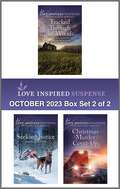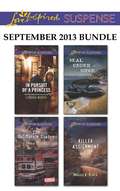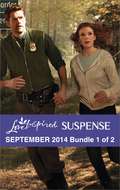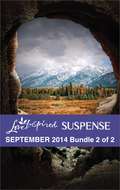- Table View
- List View
Love Inspired Suspense November 2024 - Box Set 1 of 2
by Terri Reed Jenna Night Deena AlexanderLove Inspired Suspense brings you three new titles! Enjoy these suspenseful romances of danger and faith.This box set includes: SEARCH AND DETECT (A Mountain Country K-9 Unit novel)by Terri ReedWhen single mother Zoe Jenkins and her baby are caught in an explosion that destroys her home, she&’s saved by FBI special agent Chase Rawlston and his K-9, Dash. But who set the bomb? Fearing that the notorious Rocky Mountain Killer he&’s been investigating has the mother and daughter in his sights, Chase takes them under his protection. But can he uncover the killer&’s identity before more innocent lives are caught in the crossfire?WITNESS PROTECTION AMBUSH (A Big Sky First Responders novel)by Jenna NightAfter eight years in witness protection, EMT Emma Hayes thought she and her family were safe in rural Montana…until their identities are compromised and she&’s nearly abducted. She&’s rescued by her coworker, paramedic Cole Webb, who vows to do whatever he can to protect her. Together, they must outrun the vicious criminals on their trail while searching for Emma&’s younger brother, who&’s put himself in the kidnappers&’ crosshairs as well. But when danger follows them to Cole&’s family ranch, their race to thwart the ruthless gang after them could be lethal.HUNTED FOR THE HOLIDAYSby Deena AlexanderWhen Shae Evans spots a familiar face at a Christmas pageant, she knows her witness-protection cover has been blown. Six years ago, her testimony put a crime boss away for life, but his vengeful son never stopped looking for her. Fleeing with her daughter, Shae accepts protection from former FBI agent Mason Payne—her child&’s secret father. Now they&’re only seconds ahead of the ruthless crime family who want Shae silenced forever. With threats everywhere, will they live to see the New Year?For more stories filled with danger and romance, look for Love Inspired Suspense November 2024 Box Set – 2 of 2
Love Inspired Suspense November 2024 - Box Set 2 of 2
by Valerie Hansen Alexis Morgan Carol J. PostLove Inspired Suspense brings you three new titles! Enjoy these suspenseful romances of danger and faith.This box set includes: UNDERCOVER ESCAPEby USA Today bestselling author Valerie HansenGoing undercover as a convicted killer is state trooper Rafe McDowell&’s best shot at shutting down a human trafficking ring. But when a surprise jailbreak ruins his plans and puts the prison&’s dog trainer, Hannah Lassiter, in danger, he must take her, her grandmother and their dog on the run from the mastermind behind the ring. With his fugitive target now after them, maintaining his cover is the only way to catch the criminal. But as the escalating attacks turn deadly, can he convince Hannah to trust him in order to keep them all alive?SNIFFING OUT JUSTICE (A Canine Defense novel)by Carol J. PostAfter witnessing her best friend&’s murder, Kristina Ashbaugh-Richards and her search and rescue dog, Bella, find themselves targeted by the killer. Kris can identify the criminal—and she&’s exactly what he looks for in his victims. Her high school crush, Detective Tony Sanderson, vows to protect Kris and her son, but as they try to outwit a dangerous murderer, no place is safe to hide. With her life at stake, Kris&’s only hope of survival is to catch the serial killer before he catches her.A LETHAL TRUTHby USA Today bestselling author Alexis MorganAubrey Sims escaped a serial killer, but she never stopped looking over her shoulder. And now her deepest fear is beginning again: the killer is back. He&’s begun playing a cat and mouse game with Aubrey, making her relive a nightmare that never really went away. Cold case detective Jonah Kelly—a man who has his own past failings to atone for—will do whatever it takes to protect Aubrey. But their wounded hearts are drawing them all too close just as the killer&’s noose tightens around them…For more stories filled with danger and romance, look for Love Inspired Suspense November 2024 Box Set – 1 of 2
Love Inspired Suspense November 2025 - Box Set 1 of 2
by Valerie Hansen Mary Alford Sami A. AbramsLove Inspired Suspense brings you three new titles! Enjoy these suspenseful romances of danger and faith.This box set includes:FINAL SHOWDOWN (A Dakota K-9 Unit novel) by USA TODAY bestselling author Valerie HansenInvestigating a gun smuggling ring leads ATF Special Agent Daniel Slater to a murder victim&’s house—and right into a drive-by shooting. With his K-9 partner, Dakota, he helps save crime scene investigator Aurora Martin from flying bullets. But there are no clues as to why Aurora is a target. Suspecting a case of mistaken identity, Daniel insists she will be safe hiding out at his home—until gunmen infiltrate the property. Now, to protect Aurora, Daniel must hunt down their attacker. But can he catch the culprit in time…or will this case be Aurora&’s last?SHATTERED AMISH IDENTITYby USA TODAY bestselling author Mary AlfordWhen Amish school teacher Hannah York is attacked, she defends herself with skills she never knew she had. CIA agent Titus Miller arrives, claiming that she&’s actually fellow agent Lara Redmond—and that she&’s in danger from a powerful enemy. Despite suffering from amnesia, Hannah is certain she&’s only ever lived a quiet Amish life. But why does Titus seem so familiar, and could it be true that he loved her once? When Hannah&’s family is abducted, she and Titus must work together to find them. Can Hannah trust him to help unlock the truth of her past…and keep her safe?CHRISTMAS RODEO KILLER (A Stone Creek Ranch novel)by Sami A. AbramsAfter four suspicious deaths on the local rodeo circuit, rodeo bull rider turned FBI agent Cooper Sinclair returns to the arena undercover—and is nearly killed on his first ride. Rescued by his former love, private investigator Grace Harrison, Cooper learns she is also looking into the murders and believes he&’s the next target. With more innocent lives on the line, Cooper must join forces with the woman who gave up their baby for adoption. And when the deadly attacks zero in on Grace, can Cooper keep her alive long enough to bring a killer to justice…and reveal his own shocking secret?For more stories filled with danger and romance, look for Love Inspired Suspense November 2025 Box Set – 2 of 2
Love Inspired Suspense November 2025 - Box Set 2 of 2
by Terri Reed Deena Alexander Jacqueline AdamLove Inspired Suspense brings you three new titles! Enjoy these suspenseful romances of danger and faith.This box set includes:TEXAS CHRISTMAS COVER-UP (A Texas Justice novel) by Terri ReedWhen widowed FBI agent Kara Evans returns to sell her late mother&’s home, eager to shed reminders of her tragic past, she&’s assaulted by a masked attacker. With the house ransacked and a daughter to protect, Kara must turn to her former love, police chief Jeremy Hamilton, to track down her assailant. But when the trail of clues leads to unanswered questions about her father&’s cold case murder, it&’s clear that someone is determined to keep Kara from uncovering the truth. As a string of new murders unfolds, can they expose this deadly plot before Kara is silenced forever?MISSING AT CHRISTMASby Deena AlexanderWhen journalist Lexi McKenna receives a desperate call for help, she rushes to her sister&’s home, only to find her sister dead and one of her twin nieces missing. With her past mafia ties resurfacing, Lexi must go on the run with agent Noah Thompson to protect herself from her father&’s enemies. Although Lexi is the daughter of the mob boss who murdered Noah&’s brother, Noah will do anything to take down her family—even work with her. As danger looms from all sides, they must find the abducted baby and dismantle a criminal empire before Lexi and her nieces end up as collateral damage.KIDNAPPED FOR RANSOMby Jacqueline AdamDoctor Chelsea Eidman thought she&’d finally escaped the perils of her late husband&’s secret life as a diamond thief—until his former accomplice attacks her. The danger escalates when a vengeful mobster kidnaps Chelsea&’s daughter and friend, demanding the stolen diamonds in exchange for their lives. To recover the gems, Chelsea joins forces with officer Matt Reynolds, whose sister has also been abducted. As they race against time, they find themselves in deadly pursuits across harsh terrain. With everything on the line, Chelsea and Matt must outsmart their enemies and unravel a web of lies…before their families pay the ultimate price.For more stories filled with danger and romance, look for Love Inspired Suspense November 2025 Box Set – 1 of 2
Love Inspired Suspense October 2013 Bundle
by Marta Perry Kit Wilkinson Diane Burke Kathleen Tailer Susan Sleeman Katy LeeLove Inspired Suspense brings you four new titles for one great price, available now for a limited time only from November 1 to November 30! Enjoy these contemporary heart-pounding tales of suspense, romance, hope and faith. This Love Inspired Suspense bundle includes High-Stakes Holiday Reunion by Christy Barritt, Her Mistletoe Protector by Laura Scott, Montana Standoff by Sharon Dunn and Texas K-9 Unit Christmas by Shirlee McCoy and Terri Reed. Look for four new inspirational suspense stories every month from Love Inspired Suspense!
Love Inspired Suspense October 2013 Bundle
by Kathleen Tailer Susan Sleeman Katy LeeLove Inspired Suspense brings you four new titles for one great price, available now for a limited time only from October 1 to October 31! Enjoy these contemporary heart-pounding tales of suspense, romance, hope and faith. This Love Inspired Suspense bundle includes Danger in Amish Country by Marta Perry, Diane Burke and Kit Wilkinson, Thread of Suspicion by Susan Sleeman, The Reluctant Witness by Kathleen Tailer and Warning Signs by Katy Lee.Look for four new inspirational suspense stories every month from Love Inspired Suspense!
Love Inspired Suspense October 2013 Bundle
by Kathleen Tailer Susan Sleeman Katy LeeLove Inspired Suspense brings you four new titles for one great price, available now for a limited time only from October 1 to October 31! Enjoy these contemporary heart-pounding tales of suspense, romance, hope and faith. This Love Inspired Suspense bundle includes Danger in Amish Country by Marta Perry, Diane Burke and Kit Wilkinson, Thread of Suspicion by Susan Sleeman, The Reluctant Witness by Kathleen Tailer and Warning Signs by Katy Lee.Look for four new inspirational suspense stories every month from Love Inspired Suspense!
Love Inspired Suspense October 2013 Bundle
by Kathleen Tailer Susan Sleeman Katy LeeLove Inspired Suspense brings you four new titles for one great price, available now for a limited time only from October 1 to October 31! Enjoy these contemporary heart-pounding tales of suspense, romance, hope and faith. This Love Inspired Suspense bundle includes Danger in Amish Country by Marta Perry, Diane Burke and Kit Wilkinson, Thread of Suspicion by Susan Sleeman, The Reluctant Witness by Kathleen Tailer and Warning Signs by Katy Lee.Look for four new inspirational suspense stories every month from Love Inspired Suspense!
Love Inspired Suspense October 2014 - Box Set 1 of 2
by Debby Giusti Lynette Eason Sarah VarlandMore of the suspense you love-now Love Inspired Suspense brings you six new titles, in two convenient bundles! Enjoy these contemporary heart-pounding tales of suspense, romance, hope and faith. This Love Inspired Suspense bundle includes The Lawman Returns by Lynette Eason, Holiday Defenders by Debby Giusti, Susan Sleeman and Jodie Bailey and Tundra Threat by Sarah Varland. Look for six new inspirational suspense stories every month from Love Inspired Suspense!
Love Inspired Suspense October 2014 - Box Set 2 of 2
by Laura Scott Hope White Jane M. ChoateMore of the suspense you love-now Love Inspired Suspense brings you six new titles, in two convenient bundles! Enjoy these contemporary heart-pounding tales of suspense, romance, hope and faith. This Love Inspired Suspense bundle includes Down to the Wire by Laura Scott, Covert Christmas by Hope White and Keeping Watch by Jane M. Choate. Look for six new inspirational suspense stories every month from Love Inspired Suspense!
Love Inspired Suspense October 2014 Box Set 1 of 2
by Debby Giusti Lynette Eason Susan Sleeman Jodie Bailey Sarah VarlandLove Inspired Suspense October 2014 Box Set 1 of 2
Love Inspired Suspense October 2014 Box Set 2 of 2
by Laura Scott Hope White Jane M. ChoateLove Inspired Suspense October 2014 Box Set 2 of 2
Love Inspired Suspense October 2021 - Box Set 1 of 2
by Heather Woodhaven Dana R. Lynn Anne GalbraithLove Inspired Suspense brings you three new titles! Enjoy these suspenseful romances of danger and faith. This box set includes:ARCTIC WITNESS (An Alaska K-9 Unit novel)ByHeather WoodhavenWhen his ex-wife goes missing in the Alaskan wilderness after discovering a body, Alaska State Trooper Sean West and his K-9 partner, Grace, rescue her from a kidnapper. Now the murderer is on their trail, and it&’s up to Sean to protect Ivy and the little boy she plans to adopt. COVERT AMISH INVESTIGATION (An Amish Country Justice novel)By USA TODAY bestselling author Dana R. LynnPolice officer Kate Bontrager never planned to return to her Amish roots, but with a woman missing from witness protection in Kate&’s former community, she has no choice. The moment she arrives for her undercover assignment, she becomes a target…and working with her ex, Abram Burkholder, is her only hope of staying alive. KIDNAP THREATBy Anne GalbraithA mole in the police department thrusts a witness&’s mother right into a deadly gang&’s crosshairs. They&’ll kill anyone to keep Alice Benoit&’s son from testifying. Now it&’s up to officer Ben Parsons to protect Alice for twenty-four hours in a busy city…or a killer could go free.For more stories filled with danger and romance, look for Love Inspired Suspense October 2021 Box Set – 2 of 2
Love Inspired Suspense October 2021 - Box Set 2 of 2
by Lynette Eason Kerry Johnson Elizabeth GoddardLove Inspired Suspense brings you three new titles at a great value, available now! Enjoy these suspenseful romances of danger and faith.This box set includes: MOUNTAIN FUGITIVEBy Lynette EasonOut on a horseback ride, Dr. Kathrine Gilroy stumbles into the middle of a shoot-out. Now with US Marshal Dominic O&’Ryan injured and under her care, she&’s determined to help him find the fugitive who killed his partner…before they both end up dead. HIGH STAKES ESCAPE (A Mount Shasta Secrets novel)By USA TODAY Bestselling Author Elizabeth GoddardSomeone is killing off deputy US marshal Ben Bradley&’s witnesses one by one, and he won&’t let Chasey Cook become the next victim. But on the run with a leak in the Marshals Service and murderers drawing closer, he and Chasey have no one to trust. Can he shield her from danger on his own? SNOWSTORM SABOTAGEBy Kerry JohnsonAfter single mom Everly Raven finds her friend murdered inside a chalet on her family&’s ski resort, the blame falls on her. With a blizzard closing in and the killer&’s henchmen chasing her down a mountain, Everly must work with FBI agent Isaac Rhodes—the father of her secret child—to clear her name. For more stories filled with danger and romance, look for Love Inspired Suspense October 2021 Box Set – 1 of 2
Love Inspired Suspense October 2022 - Box Set 1 of 2
by Valerie Hansen Maggie K. Black Rhonda StarnesLove Inspired Suspense brings you three new titles! Enjoy these suspenseful romances of danger and faith. This box set includes: EXPLOSIVE REVENGE (A Rocky Mountain K-9 Unit novel)by USA TODAY bestselling author Maggie K. BlackAfter months of someone sabotaging their K-9 unit, Sargent Tyson Wilkes and K-9 Echo must scramble to uncover the culprit before their unit is disbanded. But when all signs point to a link with Detective Skylar Morgan&’s drug case, will working together be enough to stop the criminal…and keep them alive? SERIAL THREAT (An Emergency Responders novel)by USA TODAY bestselling author Valerie HansenA series of murders in her small Missouri town leads police officer Emily Zwalt straight to old friend and attorney Noah Holden. With connections to all the victims, Noah&’s the main suspect. He&’ll have to enlist Emily&’s aid to unmask the real killer before he can strike again. TRACKED THROUGH THE MOUNTAINSby Rhonda StarnesWhen FBI profiler Sawyer Eldridge receives chilling threats from a serial killer who abducts his half-sister for revenge, he enlists bodyguard Bridget Vincent to track down the murderer. Except Bridget&’s also on the hit list and saving them both might not be possible… For more stories filled with danger and romance, look for Love Inspired Suspense October 2022 Box Set – 2 of 2
Love Inspired Suspense October 2022 - Box Set 2 of 2
by Laurie Alice Eakes Terri Reed Sharon DunnLove Inspired Suspense brings you three new titles! Enjoy these suspenseful romances of danger and faith. This box set includes: FORCED TO FLEEby Terri ReedDiscovering a family secret instantly marks reserved banker Abby Frost as the target of a vicious cartel searching for her father. Tasked with keeping her safe, can US Marshal Jace Armstrong help Abby find the answers that&’s she looking for about her true identity before she falls into the crime ring&’s clutches? CHRISTMAS HOSTAGEby Sharon DunnTaken hostage by bank robbers, security expert Laura Devin suspects one of the thieves is not who he appears to be. And when undercover FBI Agent Hollis Pryce is forced to blow his cover to free Laura, he&’ll risk everything to assist her escape from the Montana mountains and the criminal mastermind hunting them… ABDUCTION RESCUEby Laurie Alice EakesDesperate to find his missing sister, Ethan McClure seeks out private investigator Melissa &“Mel&” Carter—only to be attacked right outside her agency&’s door. Though she&’s reluctant to help after her last case turned violent, Mel won&’t turn Ethan away. But can they avoid becoming pawns in the abductor&’s dangerous game? For more stories filled with danger and romance, look for Love Inspired Suspense October 2022 Box Set – 1 of 2
Love Inspired Suspense October 2023 - Box Set 1 of 2
by Maggie K. Black Dana R. Lynn Connie QueenLove Inspired Suspense brings you three new titles! Enjoy these suspenseful romances of danger and faith. This box set includes: UNDERCOVER OPERATION (A Pacific Northwest K-9 novel)by USA TODAY Bestselling Author Maggie K. BlackAfter three bloodhound puppies are stolen, K-9 officer Asher Gilmore and trainer Peyton Burns are forced to go undercover as married drug smugglers to rescue them. But infiltrating the criminals will be more dangerous than expected, putting the operation, the puppies and their own lives at risk. HUNTED AT CHRISTMAS (An Amish Country Justice novel)by USA TODAY Bestselling Author Dana R. LynnWhen single mother Addison Johnson is attacked by a hit man, she learns there&’s a price on her head. Soon it becomes clear that Isaiah Bender—the bounty hunter hired to track her down for crimes she didn&’t commit—is her only hope for survival. RESCUING THE STOLEN CHILDby Connie QueenWhen Texas Ranger Zane Adcock&’s grandson is kidnapped and used as leverage to get Zane to investigate an old murder case, he calls his ex-fiancée for help. Zane and retired US marshal Bliss Walker will risk their lives to take down the criminals…and find the missing boy before it&’s too late. For more stories filled with danger and romance, look for Love Inspired Suspense October 2023 Box Set – 2 of 2
Love Inspired Suspense October 2023 - Box Set 2 of 2: Box Set 2 Of 2
by Laura Scott Sharee Stover Shannon RedmonLove Inspired Suspense brings you three new titles! Enjoy these suspenseful romances of danger and faith. This box set includes: TRACKED THROUGH THE WOODSby USA TODAY Bestselling Author Laura ScottAbby Miller is determined to find her missing FBI informant father before the mafia does, but time is running out. Can she trust special agent Wyatt Kane to protect her from the gunmen on her trail, to locate her father—and to uncover an FBI mole? SEEKING JUSTICEby Sharee StoverWith her undercover operation in jeopardy, FBI agent Tiandra Daugherty replaces her injured partner with his identical twin brother, Officer Elijah Kenyon. But saving her mission puts Elijah in danger. Can Tiandra and her K-9 keep him alive before he becomes the next target? CHRISTMAS MURDER COVER-UPby Shannon RedmonAfter Detective Liz Burke finds her confidential informant dead and interrupts the killer's escape, she's knocked unconscious and struggles to remember the details of the murder. With a target on her back, she must team up with homicide detective Oz Kelly to unravel a deadly scheme—and stay alive. For more stories filled with danger and romance, look for Love Inspired Suspense October 2023 Box Set – 1 of 2
Love Inspired Suspense October 2024 - Box Set 1 of 2
by Sharon Dunn Sharee Stover Amity SteffenLove Inspired Suspense brings you three new titles! Enjoy these suspenseful romances of danger and faith.This box set includes: TRACING A KILLER (A Mountain Country K-9 Unit novel)by USA TODAY bestselling author Sharon DunnWhile tasked with protecting Trevor Gage from a serial killer, K-9 officer Hannah Scott inadvertently puts a second cold case murderer on their trail. The man who drowned Hannah&’s childhood friend is back—and he wants to make Hannah his next victim. Guarding Trevor becomes a survival mission once they both become the target of ruthless criminals. On a remote island with only each other to rely on, there&’s nowhere to run. And with twice the deadly traps, any misstep could prove fatal.GUARDED BY THE MARSHALby Sharee StoverWhen police chief Dani Fontaine gets an emergency call, she never expects to be ambushed by gunfire—or to find her friend&’s abandoned baby. Now Dani must keep the child safe, while evading assailants and investigating a leak in her department. And that means working with Deputy US Marshal Beckham Walsh, the man who almost destroyed her career. Protecting a child while searching for stolen weapons becomes more perilous at every turn. And with a target on their backs and multiple suspects, it could be their deadliest mission yet…MONTANA HIDDEN DECEPTIONby Amity SteffenNurse Nina Montgomery finds herself evading gunfire in the woods of Montana after unknowingly stumbling upon a man burying evidence of his crimes. When slashed tires and an explosion make it clear that the criminal knows Nina&’s identity, Detective Mateo Bianchi races to search for a deadly assailant who will stop at nothing to silence Nina and keep the truth hidden. Can they brave the wilderness and unmask a hidden killer, or will they find themselves the next victims?For more stories filled with danger and romance, look for Love Inspired Suspense October 2024 Box Set – 2 of 2
Love Inspired Suspense October 2024 - Box Set 2 of 2
by Jill Elizabeth Nelson Cathy McDavid Darlene L. TurnerLove Inspired Suspense brings you three new titles! Enjoy these suspenseful romances of danger and faith.This box set includes: K-9 RANCH PROTECTION (A Crisis Rescue Team novel)by Darlene L. TurnerPolice constable Izzy Tremblay knows her father&’s death was no accident, so when she finally discovers a lead and is immediately attacked, her suspicions are confirmed. The ambush leaves her in the hospital with three hours of crucial memory missing, which she knows holds the key to finding her father&’s murderer. For protection, she takes refuge with her ex-partner, Austin Murray, on his K-9 ranch while she races to uncover the truth. But with danger still lurking, can they stay alive long enough to take down a killer?TEXAS REVENGE TARGETby Jill Elizabeth NelsonAfter Texas Ranger Brianna Macguire catches up with the fugitive she&’s hunting, she finds herself ensnared in the crosshairs of a revenge-driven cartel—and evading a sniper attack. Cameron Wolfe, a man in hiding and with a bounty on his head, offers Bree shelter…only for Cameron&’s secrets and Bree&’s attackers to catch up with them both. While they're on the run in the Texas desert, danger stalks them at every turn. Can they outwit their relentless enemies before they both lose their lives?DEADLY SECRETSby New York Times bestselling author Cathy McDavidRancher Ridge Burnham unearths a gun and a strongbox of cash on his property—possible leads in his father&’s unsolved murder. The sheriff&’s department has ignored the case for years, but rookie deputy Elena Tomes is determined to prove herself by helping him find the truth. Faced with the town&’s sordid history of drug running, Elena and Ridge must work together and trust each other. Now this decades-old cold case will expose the rot in their small ranching community…and the secrets that someone will kill for.For more stories filled with danger and romance, look for Love Inspired Suspense October 2024 Box Set – 1 of 2
Love Inspired Suspense October 2025 - Box Set 1 of 2
by Sharon Dunn Elisabeth Rees Jenna NightLove Inspired Suspense brings you three new titles! Enjoy these suspenseful romances of danger and faith.This box set includes:DOUBLE PROTECTION DUTY (A Dakota K-9 Unit novel)by USA TODAY bestselling author Sharon DunnA family trip to the Wind Caves National Park quickly turns into a nightmare when K-9 officer Kenyon Graves discovers one of his twin boys has been abducted. Now Kenyon needs the help of his team and his longtime friend Raina McCord to save his toddler son. But the kidnappers are elusive—and intent on killing anyone who stands in the way of their sinister scheme. With threats closing in, time is of the essence to catch these criminals…before Kenyon and Raina pay the ultimate price.DANGEROUS MONTANA INHERITANCE (A Big Sky First Responders novel)by Jenna NightAttacked on the property she unexpectedly inherited, Rose Balfour barely escapes with the help of former hostage negotiator Henry Walsh. Someone is determined to keep her from testifying at a loan shark&’s murder trial. But when she does and the danger continues, Rose suspects there are answers in the house left to her. Teaming up with Henry, Rose uncovers surprising evidence and a powerful enemy determined to silence them. Not even Henry&’s isolated ranch is a safe refuge. With their lives on the line and captors closing in, can Rose and Henry expose the web of secrets—before they vanish forever?DISAPPEARANCE IN ALASKAby Elisabeth ReesThe last thing Ava Kindred remembers before being thrown off a cliff and left for dead in the Alaskan wilderness is witnessing her friend&’s abduction. And when she&’s saved by local police chief Mark Tremblay, she enlists his help to track her down. Except no trace of this woman&’s existence can be found and their search only leads to dead ends. But they can&’t deny that Ava&’s life is in danger. With time running out and unknown enemies just steps behind, can they discover what really happened before Ava&’s permanently silenced?For more stories filled with danger and romance, look for Love Inspired Suspense October 2025 Box Set – 2 of 2
Love Inspired Suspense October 2025 - Box Set 2 of 2
by Laura Scott Carrie Stuart Parks Jennifer PierceLove Inspired Suspense brings you three new titles! Enjoy these suspenseful romances of danger and faith.This box set includes:TEXAS RANGER DEFENDER (A Texas Justice novel) by USA TODAY bestselling author Laura ScottWhen Texas ranger Tucker Powell hears gunshots on his ranch and finds a woman in bloodstained clothes who is desperate for help, he offers her shelter. She claims to have no memories of who she is or how she got there, but is certain that she&’s in danger. And when Tucker discovers a dead body on his property and more bullets start flying, he is determined to unravel the mystery. But will the search for answers prove her innocent of murder…or cost them both their lives?ESCAPING THE WILDERNESSby Carrie Stuart ParksAmanda Cotton&’s privileged life takes a harrowing turn when her grandfather&’s dying wish places a target firmly on her back and she&’s attacked by unknown assailants. Rescue comes in the form of widowed outdoorsman Boone McGregor, but the threat is just beginning. Unable to trust local law enforcement, they flee across the rugged Montana mountains. As they evade deadly enemies and navigate harsh terrain, they must put aside their differences to survive. But when a family secret is exposed, danger is closer than they imagined and more than just their lives is at stake…TRAIL OF SUSPICIONby Jennifer PierceWhen crime scene technician Aurora &“Rory&” James and her K-9, Moose, stumble upon a dead body in the woods, she finds herself fighting off a killer who wants to hide his crimes. Although she&’s the criminal&’s next target, Rory doesn&’t want protection from Sergeant Asher Mitchell—the man who implicated her father in her mother&’s disappearance years ago. But as the attacks escalate and they discover that a second body belongs to Rory&’s missing mother, Asher realizes that the murderer will do anything to stop the police investigation. Can Rory and Asher catch the culprit before they become the next victims?For more stories filled with danger and romance, look for Love Inspired Suspense October 2025 Box Set – 1 of 2
Love Inspired Suspense September 2013 Bundle
by Lenora Worth Debby Giusti Liz Johnson Maggie K. BlackLove Inspired Suspense brings you four new titles for one great price, available now for a limited time only from September 1 to September 30! Enjoy these contemporary heart-pounding tales of suspense, romance, hope and faith. This Love Inspired Suspense bundle includes In Pursuit of a Princess by Lenora Worth, The Soldier's Sister by Debby Giusti, SEAL Under Siege by Liz Johnson and Killer Assignment by Maggie K. Black.Look for four new inspirational suspense stories every month from Love Inspired Suspense!
Love Inspired Suspense September 2014 - Bundle 1 of 2
by Terri Reed Christy Barritt Lisa PhillipsMore of the suspense you love-now Love Inspired Suspense brings you six new titles, in two convenient bundles! Enjoy these contemporary heart-pounding tales of suspense, romance, hope and faith. This Love Inspired Suspense bundle includes Danger at the Border by Terri Reed, Desperate Measures by Christy Barritt and Star Witness by Lisa Phillips. Look for six new inspirational suspense stories every month from Love Inspired Suspense!
Love Inspired Suspense September 2014 - Bundle 2 of 2
by Vickie Mcdonough Sharon Dunn Katy LeeMore of the suspense you love-now Love Inspired Suspense brings you six new titles, in two convenient bundles! Enjoy these contemporary heart-pounding tales of suspense, romance, hope and faith. This Love Inspired Suspense bundle includes Wilderness Target by Sharon Dunn, Sunken Treasure by Katy Lee and Rancher Under Fire by Vickie McDonough.Look for six new inspirational suspense stories every month from Love Inspired Suspense!



